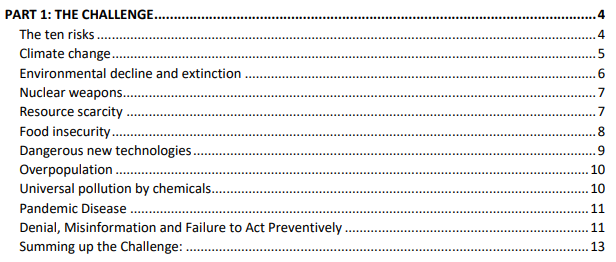The model used by Drawdown represents a solid high-level framework for how to begin developing a risk-based model:
- Identify candidate issues for consideration.
- Develop criteria to rank them.
- Apply criteria and develop a ranked list.
Although it enjoys less mainstream attention it is important to note that much work has been done already on steps 1 and 2 above, and some groups have even attempted to create ranked lists. Below is a list of such threats, from a report created in 2015.
The list is a mixed bag featuring the familiar (nuclear war, meteors, climate change) and the lesser-known, such as AI development, synthetic biology, and nanotechnology – the bad fruits of unchecked modernization.
Notably, publishing this article in 2020, after it was written in 2018-2019, we can it was spot on to include Global Pandemic as an existential risk:
There are grounds for suspecting that such a high impact epidemic is more probable than usually assumed…The world has changed considerably, making comparisons with the past problematic. Today it has better sanitation and medical research, as well as national and supra-national institutions dedicated to combating diseases. But modern transport and dense human population allow infections to spread much more rapidly.
…and alongside it, Global System Collapse.
An economic or societal collapse on the global scale…Such intricate, interconnected systems are subject to unexpected system-wide failures caused by the structure of the network – even if each component of the network is reliable. This gives rise to systemic risk, when parts that individually may function well become vulnerable when connected as a system to a self-reinforcing joint risk that can spread from part to part, potentially affecting the entire system and possibly spilling over to related outside systems.

[At some point I hope to update this with analysis of a comparable model seen in this more recent report, linked below.]

Each report uses different definitions of “risk” and thus offers different perspectives on risks as a result. This is an excellent example of the importance of defining risk.
Footnotes
[1] Global Challenges Foundation. (2015). 12 risks that threaten human civilization – The case for a new risk category. Stockholm: Global Challenges Foundation.
Pingback: Episode 4: Peter Piper picked a peck of … climate change solutions?! – The Grass Ceiling